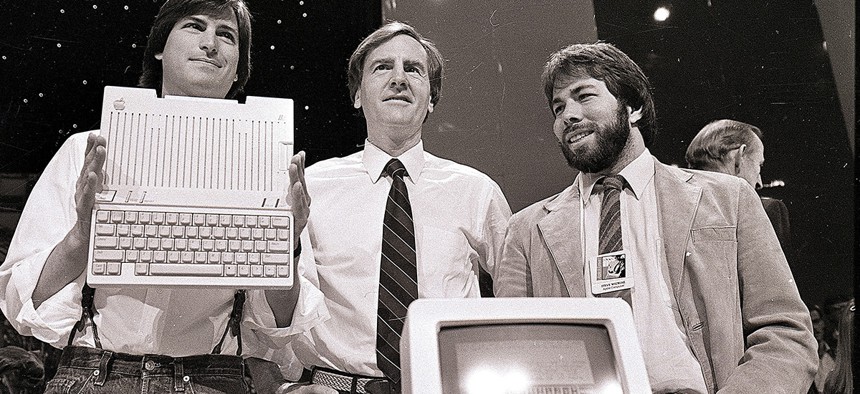Apple Turns 40

Steve Jobs, left, chairman of Apple Computers, John Sculley, center, president and CEO, and Steve Wozniak, co-founder of Apple, unveil the new Apple IIc computer in San Francisco in 1984. Sal Veder/AP File Photo
Forty years ago today, two college dropouts decided to start selling cobbled-together computers out of a garage in California because they couldn’t afford the ones on the market.
Forty years ago today, two college dropouts decided to start selling cobbled-together computers out of a garage in California because they couldn’t afford the ones on the market. They had an intricate wood-cut logo, not much money or manpower, and their first computer only sold about 175 units.
But in the years between then and now, Apple has become one of the most valuable companies in the world, spurring revolutions in how we communicate, use computers, listen to music, and to a lesser extent, tell the time.
Apple has reached what has traditionally been considered middle age, and appears to be positioned to age gracefully. Many of the large U.S. consumer-facing tech companies that were the powerhouses of their day eventually fell from grace when they didn’t adapt to a change in their market—whether that was IBM with mainframes in the 1980s, Microsoft with mobile in the 2000s, or GE trying to compete in commoditized markets in the 1990s.
But in every instance, those companies, having shifted away for the most part from consumer-facing products, have made relatively strong businesses out of servicing enterprise clients, or other ventures.

Some critics (I won’t name names) think that Apple is boring now, setting itself up to iterate on its successes and lock customers into their services with products that are very good, but nothing they haven’t really seen before. This is a solid business strategy that will provide strong returns for years to come, but not those eye-popping leaps we’ve seen before. Apple’s market value and stock price has been a series of increasing peaks and troughs since former CEO Steve Jobs returned to the company and rolled out the iMac, iPod, iPhone and iPad.
You could argue that these charts suggest that Apple is following a similar path as the giants that have come before it—after their peak, a regression to a far lower mean became the norm—but Apple’s path isn’t identical. It hasn’t had one massive success that it’s built and iterated on for years, like Microsoft and Windows, but a few.
It could well be that Apple is out of big ideas—seeing as Jobs was the one credited with bringing most of Apple’s revolutionary products, especially from the late ’90s until his death—but it’s hard to count out a company with over $200 billion in cash.
There are rumors and speculation that Apple is working on virtual reality, artificial intelligence, and cars—all Big Things that could reset its course. But other companies already appear to be beating Apple to the punch in all those fields—Facebook launched the first major consumer VR headset in 20 years on March 28, and, along with Google, is leading AI research.
And then yesterday Tesla Motors opened up sales for its latest car, the Model 3, on the same day as Apple’s newest phone, the iPhone SE, went on sale. Perhaps tellingly, the lines for the $35,000 car seemed to outstrip the traditionally long lines for the latest Apple gadget.
Düsseldorf #Tesla #Model3 line next to the #Apple Store ;) pic.twitter.com/LGBv57eUbw
— Christophe HUBERT (@chris75sf) March 31, 2016
But then, Apple has found much of its success in recent years by not being the first to market. It didn’t invent the MP3 player, the smartphone, the tablet, or the laptop—it just made well-built, easy to understand, and highly desirable versions of them. Apple has perfected the art of taking something someone is doing and doing it better. It could well end up doing the same for other products we haven’t even thought of. Or maybe it’ll finally launch a TV set, or do something with the Internet of Things infrastructure it’s built with HomeKit and so far largely ignored. It could also revolutionize health care with its HealthKit and CareKit developer systems.
#jollyroger @ #apple pic.twitter.com/X6mpBw74A4
— tommy w farley (@twfarley) April 1, 2016
Today, Apple chose to fly an old pirate flag over its headquarters in Cupertino—something that used to hang on the wall of the original office when Apple was still a plucky startup. According to Mashable, one of Apple’s earliest employees, Andy Hertzfeld, said Jobs used to say “it’s better to be a pirate than join the navy.”
It was supposed to inspire a sense of rebellion and independence—something that Jobs himself embodied. Today, it’s perhaps a reminder, as the company enters what could either be a prolonged slide into boringness or the lull before the next innovation, to stay hungry, and to stay foolish.


